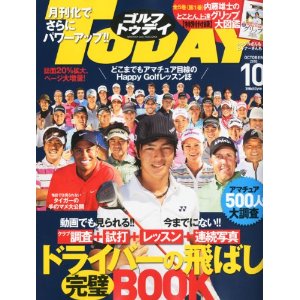 Golf Today had a really interesting article which I wanted to share with you all. They call it the Driver White Paper and it’s a collection of data surveyed from 350 random recreational and amateur golfers about driver trends.
Golf Today had a really interesting article which I wanted to share with you all. They call it the Driver White Paper and it’s a collection of data surveyed from 350 random recreational and amateur golfers about driver trends.
The survey provides some interesting results for the Driver White Paper and a look into the an average sampling of golfers in Japan when it comes to their playing ability and purchasing trends for drivers.
The survey began with basic questions about the golfers themselves like their age, average score and how long they have been playing:
The majority of golfers fit between the range of 30’s and 50’s equaling a very lucrative target audience as most are working folks in the prime of their careers meaning disposable income.
This is a telling statistic. One I always speak of here on the blog… the average golfer segment here in Japan. People always wonder why Japanese clubs have certain design aspects and so much technology to promote ease of use and distance performance many times at the cost of sacrificing feel and playability as desired by the better player. That’s because the bulk of Japanese recreational/amateur golfers fall into this average golfer category. They are the ones who spend the most trying to get to that next level. 70% of the golfers in the survey are 80-100 score players. Some of those players can certainly be considered athlete golfers but the bulk are average and many of the clubs on the market in Japan are made for these golfers.
These numbers are rather spread out and more for a reference point as the amount of time a golfer has been playing doesn’t necessarily represent their skill level or spending trends.
After the basic questions above, the survey went on to ask the players questions related to their driver and purchasing trends.
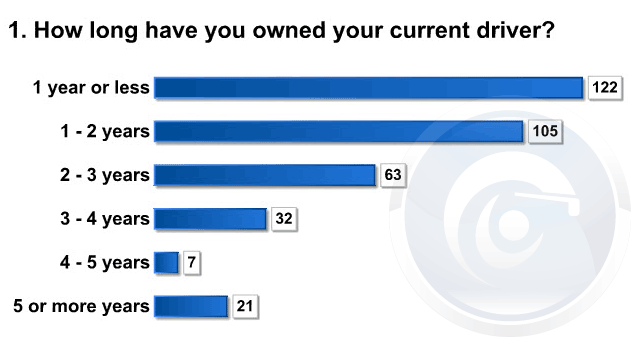 Based on the above numbers, about two thirds of the players own a driver most likely released in the last 2 years and only 17% of golfers surveyed owning a driver for longer than 3 years. 83% of players will switch a driver within 3 years.
Based on the above numbers, about two thirds of the players own a driver most likely released in the last 2 years and only 17% of golfers surveyed owning a driver for longer than 3 years. 83% of players will switch a driver within 3 years.
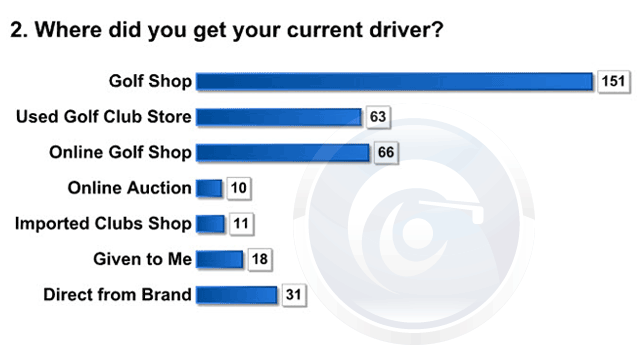 It seems in Japan the brick and mortar golf shop is still the king with nearly 45% of purchases still going through golf shops. Surprisingly online auctions were not very high, and even online golf shops being just slightly more than buying a driver at a used golf shop. Direct from the brand means the player visited an actual brand store like the PRGR store in Ginza for example.
It seems in Japan the brick and mortar golf shop is still the king with nearly 45% of purchases still going through golf shops. Surprisingly online auctions were not very high, and even online golf shops being just slightly more than buying a driver at a used golf shop. Direct from the brand means the player visited an actual brand store like the PRGR store in Ginza for example.
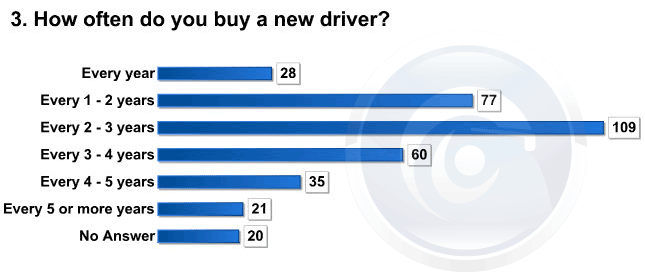 The majority of players said they bought a new driver every 2-3 years but based on question one with most players owning their current driver for under a year it would mean that a high buying cycle has taken place in the last year or 2 most likely due to the amount of high quality and new designs being available. While 460cc is the max conforming size and 0.83COR the max spring like effect of a driver head, brands in Japan have instead focused on materials, design and technology to lure buyers looking for better performance. In the last couple of years we’ve seen some great driver designs with premium forged, multi piece heads and hybrid cup variable thickness faces, ulta thin crowns and all kinds of weighting and new technologies like FCT and STR8T Fit attracting buyers of new drivers.
The majority of players said they bought a new driver every 2-3 years but based on question one with most players owning their current driver for under a year it would mean that a high buying cycle has taken place in the last year or 2 most likely due to the amount of high quality and new designs being available. While 460cc is the max conforming size and 0.83COR the max spring like effect of a driver head, brands in Japan have instead focused on materials, design and technology to lure buyers looking for better performance. In the last couple of years we’ve seen some great driver designs with premium forged, multi piece heads and hybrid cup variable thickness faces, ulta thin crowns and all kinds of weighting and new technologies like FCT and STR8T Fit attracting buyers of new drivers.
 The large majority of golfers are satisfied with their current driver but that obviously does not mean they won’t hesitate to go out and buy a new driver. Japan is a market full of trends and niches and if there are hot performing drivers out there, it won’t stop even those satisfied with their current drivers from buying.
The large majority of golfers are satisfied with their current driver but that obviously does not mean they won’t hesitate to go out and buy a new driver. Japan is a market full of trends and niches and if there are hot performing drivers out there, it won’t stop even those satisfied with their current drivers from buying.
(please note I made a typo in the above chart, the number of people willing to spend 240.00 on a driver is in fact 17 people or 5% not 5 people)
The above table has the yen values converted to US dollars for easier understanding for the reader. This is a great example of the Japanese market pricing I always talk about. Many mainstream drivers in the US from the biggest brands are in the 300.00 range or even less. So many customers always find it hard to understand why prices of Japanese drivers are so high. A lot has to do with the different market as well as exchange rates but also simply because in Japan, the demand for high end drivers is there so brands follow through by making high end expensive drivers. This is why Japan is the only market in the world that get’s all their own model clubs PLUS all the other clubs that are available in the rest of the world. Yes the ONLY market that has this arrangement.
The above table shows that of those surveyed 64% of Japanese golfers are willing to spend up to 600.00 or MORE with almost 10% willing to spend up to 1200.00 on a single driver. If these results of this survey were extrapolated, 10% of millions of golfers in Japan wanting to spend 1200.00 on a driver is happy news for the manufacturers. Even the 27% that are willing to spend around 720.00 to 960.00 on a driver is reason to celebrate for the brands. Because of these large sales on expensive clubs, brands are able to put much of the earnings from these sales into better design, materials and processes and the cycle begins again.
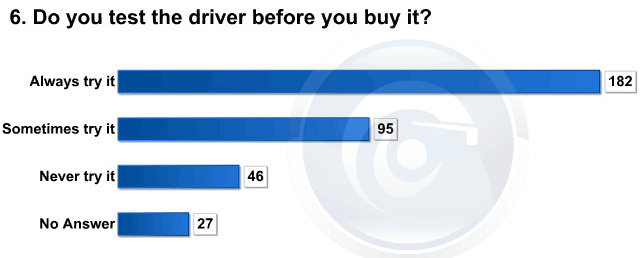 More than half of the players try a driver before buying or while they are shopping for a driver. This is one of the hardest parts of shopping online and buying JDM golf clubs for most of our customers worldwide. It’s hard buying without trying which is why we’re always here to help provide as much info and answer as many questions as we can. There is no doubt that JDM clubs are nice, and perform great but finding the right club to fit each individual’s game is the key to optimizing performance. I’ve said it many times and I’ll say it again, the best driver for player A is not necessarily the best for player B. Also there is no such thing as the longest driver or else everyone would buy that one single driver wouldn’t they? Drivers come in all shapes and sizes and designs and levels of quality. They fit all different player levels, swing types and budgets. It’s certainly not easy finding the right club but making good purchasing decisions can surely improve your score as well as your enjoyment of the game. Thanks to Golf Today for some interesting information!
More than half of the players try a driver before buying or while they are shopping for a driver. This is one of the hardest parts of shopping online and buying JDM golf clubs for most of our customers worldwide. It’s hard buying without trying which is why we’re always here to help provide as much info and answer as many questions as we can. There is no doubt that JDM clubs are nice, and perform great but finding the right club to fit each individual’s game is the key to optimizing performance. I’ve said it many times and I’ll say it again, the best driver for player A is not necessarily the best for player B. Also there is no such thing as the longest driver or else everyone would buy that one single driver wouldn’t they? Drivers come in all shapes and sizes and designs and levels of quality. They fit all different player levels, swing types and budgets. It’s certainly not easy finding the right club but making good purchasing decisions can surely improve your score as well as your enjoyment of the game. Thanks to Golf Today for some interesting information!




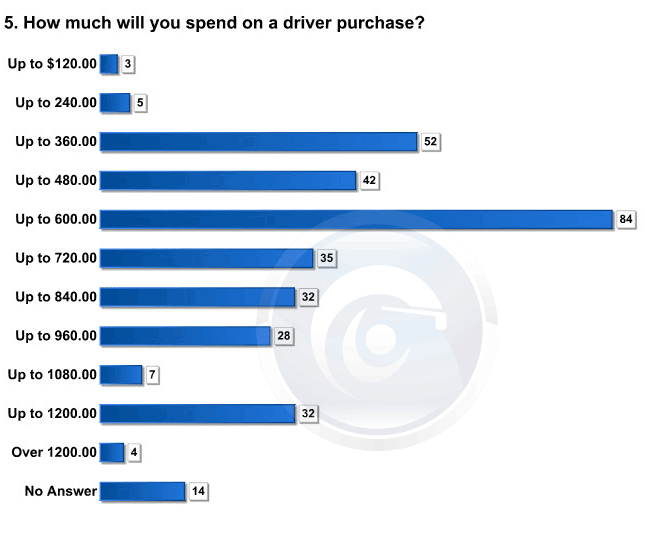

Comments 5